Kumbha Mela is the world’s largest religious fair. It is not only a display of supremacy of the Bharatiya culture, but is also a spiritual congregation that provides satsang. The Kumbha Mela held every 12 years at Prayag, Haridwar, Ujjain and Tryambakeshwar-Nashik on the occasion of the Kumbha Parva has an important place in the Hindu civilization. The spiritual glory and cultural importance of the Kumbha Parva is unique.
During the Tryambakeshwar-Nashik Kumbha Parva, Guru and Sun both come in Simha (Leo) zodiac sign. In this state, a swift fl ow of strong Tej waves emitted by the two planets runs towards the earth. During this period, the Shakti in the form of Tej is activated (with the help of radiant waves) in the form of waves in the womb of the earth at this pilgrimage place. This radiant energy in the form of waves attracts the Tej waves emitted by Guru and the sun, which are now in Simha zodiac sign, and assimilates them in its karya-shakti (Energy for performing task). Taking advantage of this arrangement, Kumbha Parva is held at this auspicious pilgrimage place.’
1. Tryambakeshwar & Nashik
These Holy places are situated on the banks of Godavari River in Maharashtra. Village of Tryambakeshwar is situated 36 kms from Nashik city, and the source of river Godavari is located in this village. The river Godavari then flows through Nashik city.
1. A. Origin and meaning of the word Tryambakeshwar
त्रयः अम्बकाः यस्य सः त्र्यम्बकः ।
स ईश्वरो यत्र तत् स्थानं त्र्यम्बकेश्वरम् ।
Implied meaning : Tryambakeshwar is the place whose presiding Deity is Deity Shiva, who has three eyes.
One of the twelve Jyotirlingas is situated in this place
1. B. Origin of the word Nashik and other names
In Tretayug, Lakshman cut off the nose of demoness Shurpanakha here; hence, it is believed that this city became famous as Nashik. The shloka given ahead mentions the names of Nashik in different Yugas.
कृते तु पद्मनगरं त्रेतायां तु त्रिकण्टकम् ।
द्वापरे तु जनस्थानं कलौ नासिकमुच्यते ॥
Meaning : In Satyayug, this city was called ‘Padmanagar’, in Tretayug ‘Trikantak’, in Dwaparyug ‘Janasthan’ and in Kaliyug, ‘Nasik (Nashik)’
1. C. Sacred Godavari tirtha
Sage Gautam performed rigorous penance to wash off the sin of killing a cow and with the power of his penance, asked Bhagawan Shiva to send Ganga from Heaven to the earth. As a result, Ganga descended at Tryambakeshwar with the new name of ‘Gautami’ or ‘Godavari’. Godavari descended onto the earth when Guru Planet was in Simha zodiac sign. When there were only seven Gods, seven Sages and seven human beings on the earth, Gautami existed with them; hence, Godavari is respected as the fi rst and most superior river. The origin period of Simhastha Parva and Godavari is the same. Nashik-Tryambakeshwar are always referred to together, because Godavari originated in Tryambakeshwar and its bed widened in Nashik.
2. Significance of the Holy place
2. A. One of the five great Holy places
It is counted among the five great Holy places in Bharat. The shloka (Hindu sacred verses) in this regard is given ahead.
नासिकं च प्रयागं च पुष्करं नैमिषं तथा ।
पञ्चमं च गयाक्षेत्रं षष्ठं कुत्र न विद्यते ॥
Meaning : There are five Holy places – Nashik, Prayag, Pushkar, Naimisharanya and Gaya. There is no equivalent sixth Holy place.
2. B. Godavari tirtha (Pilgrimage place) is Moksha-bestowing
1. One gets immense merits by donating at Kurukshetra, doing penance on the banks of Narmada and dying on the banks of Ganga; however, if all the three events happen on the banks of Godavari, it is said, the individual attains Moksha.
2. सप्तगोदाकरे स्नात्का नियतो नियताशनः ।
महत्पुण्यमकाप्नोति देकलोकं च गच्छति ॥
– Mahabharat, Parva 3, Adhyaya 83, Shloka 44
Meaning : By bathing in ‘Saptagodavar’, controlling the organs and eating less, one gets immense merits. Such an individual enters the abode of Gods after death.
3. The south-bound fl ow of Godavari is rare and Moksha-bestowing. Therefore, one gets merits by offering donations at this Holy place. This has been mentioned in ‘Kshetramahatmya’.
2. C. Tirthavidhi (Rituals performed at this Holy place)
We should perform Punyahavachan and Nandi-shraddha and bathe in the Godavari. Then, we should perform other religious actions like shraddha etc. and have darshan of Shriram situated in Panchavati. Maharshi Kashyap recommended that we should perform Pitrutarpana (Rituals for the departed ancestors) and shraddha etc. at Kusha-varta in Tryambakeshwar.
3. Darshan of the pilgrimage places
3. A. Brahmagiri
This mountain itself is the form of Deity Shiva. Deity Shiva named this mountain after Brahmadev.
3. B. Kushavarta lake
This is a very sacred lake. The flow of Ganga was obstructed by Sage Gautam with the help of ‘Kusha’ means darbha (A type of grass used in rituals); hence, the lake in Tryambakeshwar is called ‘Kushavarta’.
3. C. Panchavati
Once, the five sons of a Sage were unduly overwhelmed with the power of penance and laughed at the sun. The Sun cursed and turned them into five banyan trees. Hence, this place is called ‘Panchavati’. Later, they attained liberation by having darshan of Bhagawan Shriram.
3. D. Ramtirtha
One of the five heads of Deity Brahmadev was mischievous. Since it slandered Deity Shiva, Deity Shiva cut it off with the weapon ‘Krupal’. To get liberated from the sin of killing of Brahma’s head, Deity Shiva bathed in the Ramtirtha. Manifest-ation of ghosts, pishacha (Spirit of a deceased person) etc. and sins are destroyed by bathing in Ramtirtha. Devotees mainly take a dip in Ramtirtha (also known as Ramkunda) in Nashik, because the dip begets merits.
3. E. Asthivilaya tirtha
This tirtha is situated on the west bank of Ramtirtha of Godavari and immersing remains of the dead here is considered merit-bestowing. The bones immersed here turn into water in three and a half ghatakas (One ghatak is equivalent to 24 minutes hence, three and a half ghatakas mean 84 minutes)
(That despite releasing great amount of bones in this tirtha, they get dissolved in water is a slap in the face of the so-called scientifi cally-oriented people in the society who scoff at the Hindu scriptures. – Compilers)
3. F. Other religious places
Besides Badrikasangam, Aruna-sangamtirtha, Ramgayatirtha, there are other famous temples such as the Kapaleshwar Temple, Sundarnarayan, Ganga Temple, Rameshwar Temple, Ram Temple, Sita Cave etc.
4. Nashik Kumbh Mela
When Jupiter as well as Sun are in the Leo sign, Nashik Kumbh Mela takes place at Nashik-Tryambakeshwar. During this period, Rajyogi snan (Shahisnan) is taken during the Parvakal on 1. Shravan Krushna Panchami, 2. Shravan Krushna Amavasya, 3. Bhadrapad Shukla
Panchami (Only at Nashik) and Vaman Jayanti (Only at Tryambakeshwar). Apart from this, a special Parvakal exists during the auspicious occasions of Vaidhruti and Vyatipat.
4. A. Significance of Nashik Kumbh Mela
1. तीर्थानि नद्यश्च तथा समुद्राः क्षेत्राण्यरण्यानि तथाश्रमाश्च ।
वसन्ति सर्वाणि च वर्षमेकं गोदावरीं सिंहगते सुरेज्ये ॥
– Skandapuran
Meaning : When Jupiter is in Leo sign, all tirthas, rivers, seas, territories, forests and Ashrams exist on the bank of River Godavari
(in the subtle) for one year.
2. जनस्थाने पञ्चवट्यां सिंहस्थे च बृहस्पतौ ।
दक्षिणा गौतमी पुण्या सेवनीया प्रयत्नतः ॥
– (Reference not known)
Meaning : When Jupiter is in the Leo sign, one must bathe in the Holy River Godavari from where it turns towards the southern direction in Panchavati kshetra.
3. षष्टिर्वर्षसहस्राणि भागीरथ्यवगाहनम् ।
सकृद्गोदावरीस्नानं सिंहयुक्ते बृहस्पतौ ॥
– Brahmapuran, Adhyaya 175, Shloka 84
Meaning : The amount of merits one gets on bathing in Bhagirathi (Ganga) for 60,000 years equals to one bath in the Godavari when the Guru planet enters the Simha zodiac sign (During the Simhastha Parvakal)
4. यस्मिन् दिने गुरुः पुत्र सिंहराशिं गतो भवेत् ।
तस्मिंस्तु गौतमीस्नानं कोटिजन्माघनाशनम् ॥
(Reference not known)
Meaning : The Sage tells the king, “My son ! When Jupiter enters the Leo sign, by bathing in the River Godavari (meaning Gautami),
sins of crores of births are washed away”.
5. Rituals during Nashik Kumbh Mela pilgrimage
We should perform Punyahavachan and Nandi-shraddha and bathe in the Godavari. Then, we should perform other religious actions like shraddha etc. and have darshan of Shriram situated in Panchavati. Maharshi Kashyap recommended that we should perform Pitrutarpana (Rituals for the departed ancestors) and shraddha etc. at Kushavarta in Tryambakeshwar during the Simhastha Parva. Therefore, we should proceed from Nashik to Tryambakeshwar and perform religious actions such as a Holy bath, shraddha etc. on Kushavarta and have darshan of Tryambakeshwar. We should then return to Nashik and again have darshan of Shriram in Panchavati, worship Godavari, offer Her arghya (Respectful offerings of water etc.) in the form of fruits. We should then make offerings to Brahmans,
tonsure our head and observe a salt-less fast. Here ends the ritual of Simhastha pilgrimage.
5. A. Importance of Mundan Sanskar (Tonsuring) during the Nashik Kumbh mela
आत्मनः शुद्धिकामो वा पितृणां मुक्तिहेतवे ।
वपनं कारयिष्यामि तीरेहं तव गौतमी ॥
Meaning : O, River Gautami (Godavari), I am tonsuring on your banks in order to purify myself and for the liberation of my ancestors.
5. B. Importance of donating Ghrutakumbha during the Nashik kumbh mela
An important ritual of donating Ghrutakumbha is performed only during the Simhastha Parva in Nashik. One donating Ghrutakumbha with faith gets liberated from the cycles of birth and death.
हिरण्यपुत्रिकायुक्तं रक्तवस्त्रं सदक्षिणम् ।
गोशतस्य प्रतिनिधिं घृतकुम्भं ददाम्यहम् ॥ – (Reference not known)
Meaning : A Kumbha (made of copper), in which a gold Idol has been placed, which is covered with red cloth, fi lled with pure ghee (Clarified butter) and offering in cash is equivalent to donating 100 cows. I am donating such a Kumbha.
Reference : Sanatan Sanstha’s Holy text ‘Glory of the Kumbha Parva‘

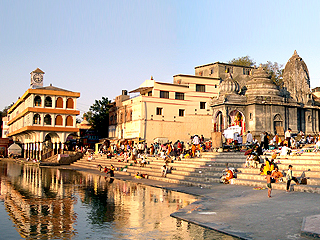
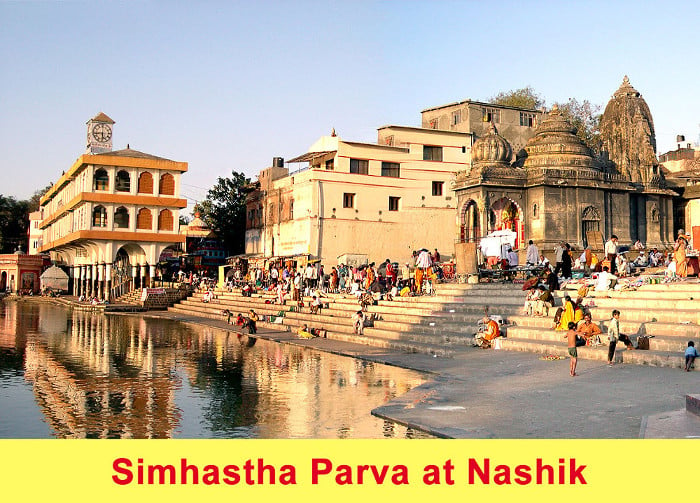
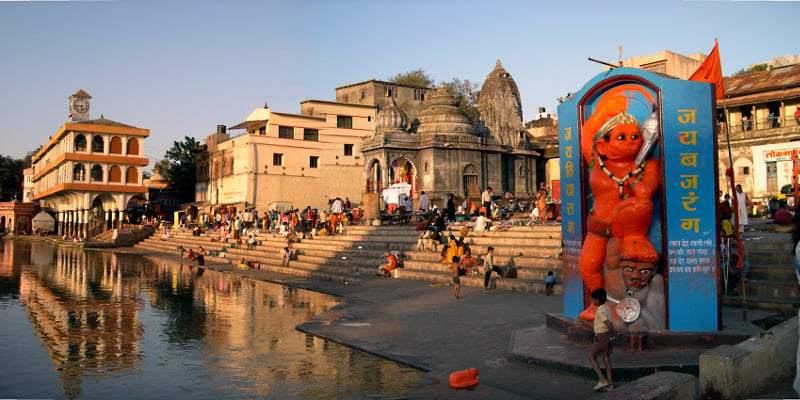
 Holy river
Holy river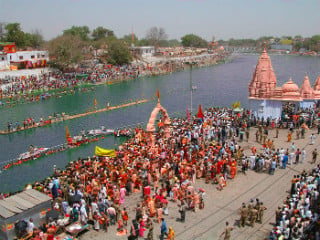 Bathing ghats located along Shipra River
Bathing ghats located along Shipra River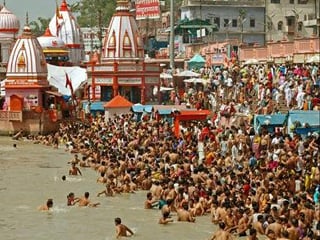 Main Bathing Dates for Kumbha Parva at Haridwar 2021
Main Bathing Dates for Kumbha Parva at Haridwar 2021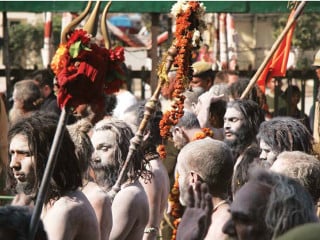 What is Akhada - List of Akhadas
What is Akhada - List of Akhadas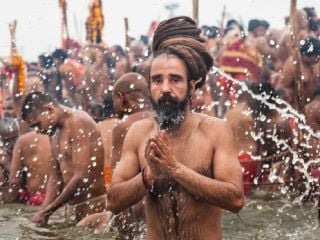 Shahi snan meaning and importance
Shahi snan meaning and importance